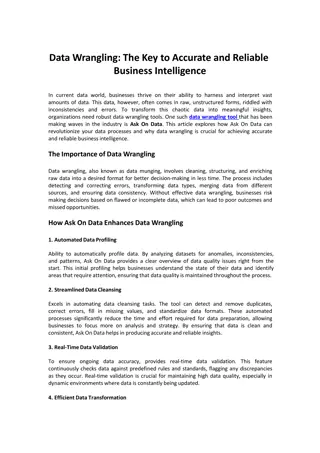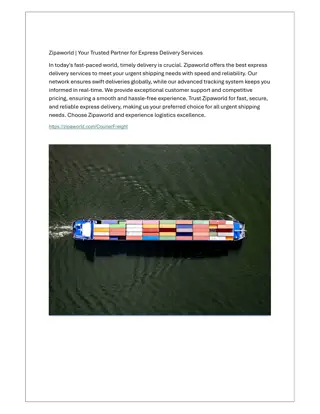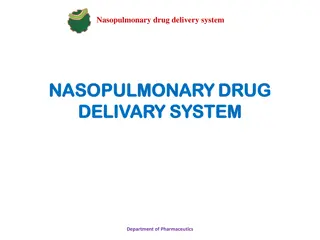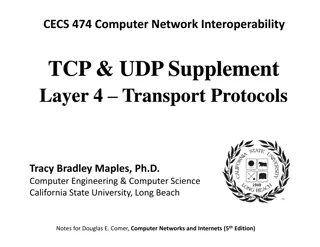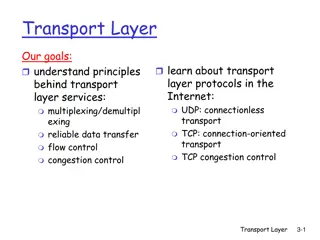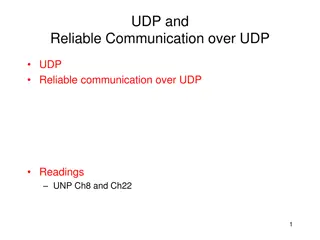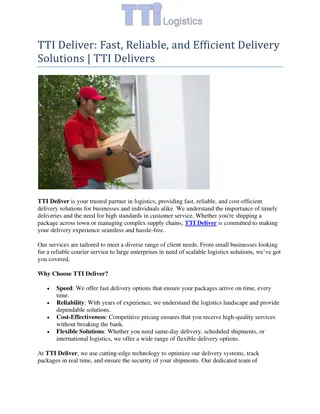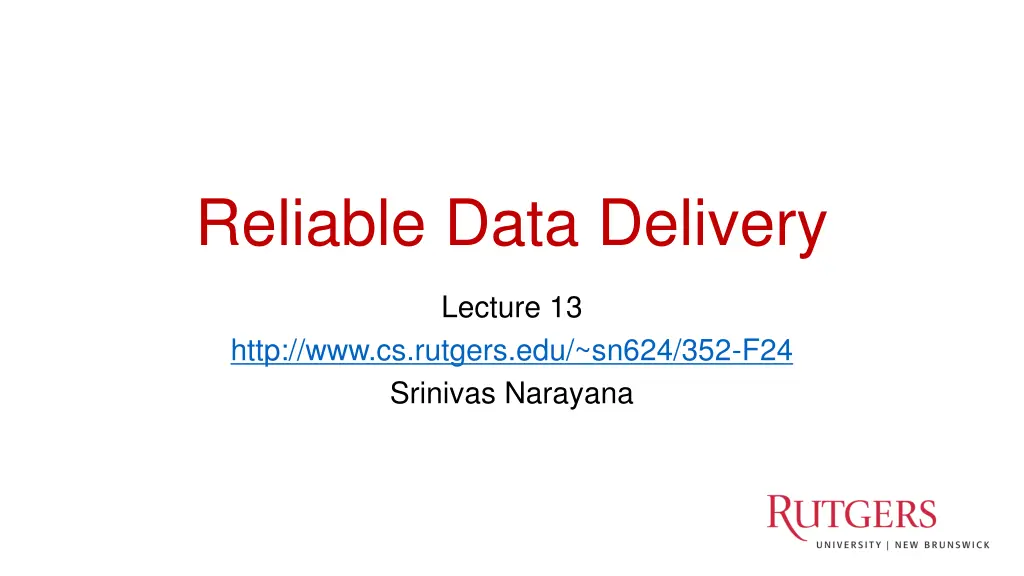
Understanding Reliable Data Delivery and Checksum Functions
Learn about reliable data delivery in Lecture 13, understanding UDP, demultiplexing, and checksum functions for error detection. Explore considerations for designing efficient checksum functions and the limitations of checksums in ensuring reliable data delivery.
Download Presentation

Please find below an Image/Link to download the presentation.
The content on the website is provided AS IS for your information and personal use only. It may not be sold, licensed, or shared on other websites without obtaining consent from the author. If you encounter any issues during the download, it is possible that the publisher has removed the file from their server.
You are allowed to download the files provided on this website for personal or commercial use, subject to the condition that they are used lawfully. All files are the property of their respective owners.
The content on the website is provided AS IS for your information and personal use only. It may not be sold, licensed, or shared on other websites without obtaining consent from the author.
E N D
Presentation Transcript
Reliable Data Delivery Lecture 13 http://www.cs.rutgers.edu/~sn624/352-F24 Srinivas Narayana 1
Review UDP: best-effort delivery + demultiplexing + error detection Checksum function: 1s complement of the 1s complement sum Sender: compute checksum & write. Receiver: compute checksum, compare to 0 1 1 1 1 0 0 1 1 0 0 1 1 0 0 1 1 0 1 1 1 0 1 0 1 0 1 0 1 0 1 0 1 0 1 wraparound 1 1 0 1 1 1 0 1 1 1 0 1 1 1 0 1 1 sum 1 1 0 1 1 1 0 1 1 1 0 1 1 1 1 0 0 1 0 1 0 0 0 1 0 0 0 1 0 0 0 0 1 1 checksum 2
Not on the exam https://datatracker.ietf.org/doc/html/rfc1071 Checksum, why you being weird? Need a function that is fast to compute, catches likely errors, and easy to verify. Some design considerations: Basic bit-wise: AND, OR: many inputs map to the same output XOR: can catch single bit-flips, but not an even number of 1s/0s flipping Some sort of addition is preferable to this (carries will show errors) Addition is commutative, associative, has an identity element (0), is efficient to calculate Checksum can appear anywhere in the packet Compute checksum by placing a 0 in place originally Use operations at the natural bit-width of the machine (16 bits was common) (Regular) two s complement addition: errors in higher order bit positions can be missed (the final carry-out bit isn t part of the checksum) One s complement: adding the final carry-out to the result helps Why complement? Why not compare the checksum rather than to 0? CPUs have ways of detecting if the last result was 0
Some observations on checksums Checksums don t detect all bit errors Consider (x, y) vs. (x 1, y + 1) as adjacent 16-bit values in packet Analogy: you can t assume the package hasn t been meddled with if its weight matches the one on the stamp. More smarts needed for that. But it s a lightweight method that works well in many cases Checksums are part of the packet; they can get corrupted too The receiver will just declare an error if it finds an error
Some observations on checksums Checksums are insufficient for reliable data delivery If a packet is lost, so is its checksum UDP and TCP use the same checksum function TCP also uses the lightweight error detection capability However, TCP has more mature mechanisms for reliable data delivery (up next!) Checksum is a mechanism to detect errors, not correct them Even when they detect errors, checksums don t tell you where they lie
Playing with checksums Let s craft some UDP packets (again)! sudo tcpdump -i lo udp XAvvv # observe packets sudo scapy # tool used to send crafted packets send(IP(dst="127.0.0.1")/UDP(sport=1024, dport=2048)/"hello world , iface="lo") Now can you craft two UDP packets with an identical checksum?
Summary of UDP A simple transport: Send or receive a single packet from/to the correct application process. That s it Just a thin shim around network layer s best-effort delivery No connection building, no latency Suitable for one-off request/response messages Sometimes suitable for loss-tolerant but delay-sensitive applications No reliability, performance, or ordering guarantees Can do basic error detection (bit flips) using checksums Error detection is necessary to deliver data reliably, but it is insufficient
Packet loss Receiver Sender How might a sender and receiver ensure that data is delivered reliably (despite some packets being lost)? TCP uses three mechanisms
Coping with packet loss: (1) ACK Receiver Sender Key idea: Receiver returns an acknowledgment (ACK) per packet sent packet ACK If sender receives an ACK, it knows that the receiver got the packet. packet ACK
Coping with packet corruption: (1) ACK Receiver Sender ACKs also work to detect packet corruption on the way to the receiver One possibility: A receiver could send a negative acknowledgment, or a NAK, if it receives a corrupted packet Q: How to detect corrupted packet? One method: Checksum! packet NAK packet TCP only uses positive ACKs. ACK
Coping with packet loss: (2) RTO Receiver Sender What if a packet is dropped? Key idea: Wait for a duration of time (called retransmission timeout or RTO) before re-sending the packet RTO In TCP, the onus is on the sender to retransmit lost data when ACKs are not received Retransmission ACK Note that retransmission works also if ACKs are lost or delayed
How should the RTO be set? Receiver Sender A good RTO must predict the round-trip time (RTT) between the sender and receiver RTT: the time to send a single packet and receive a (corresponding) single ACK at the sender RTO Intuition: If an ACK hasn t returned, and our (best estimate of) RTT has elapsed, the packet was likely dropped. ACK RTT can be measured directly at the sender. No receiver or router help needed.
Coping with packet duplication Receiver Sender If ACKs delayed beyond the RTO, sender may retransmit the same data Receiver wouldn t know that it just received duplicate data from this retransmitted packet RTO Duplicate packet received! (Receiver doesn t know ) Add some identification to each packet to help distinguish between adjacent transmissions This is known as the sequence number ACK
Coping with packet loss: (3) Sequence #s Receiver Sender A bad scenario: Suppose an ACK was delayed beyond the RTO; sender ended up retransmitting the packet. 0 RTO At the receiver: sequence number helps disambiguate a fresh transmission from a retransmission Sequence number same as earlier: retransmission Fresh sequence number: fresh data 0 ACK
Coping with packet loss: (3) Sequence #s Receiver Sender A good scenario: packet successfully received and ACK returned within RTO SEQ 0 Receiver knows these are not duplicate, because sequence numbers are different RTO ACK Sequence numbers of successively transmitted packets are different SEQ 1 RTO
Coping with packet loss: (3) Sequence #s Receiver Sender A good scenario: packet successfully received and ACK returned within RTO SEQ 0 Receiver knows these are not duplicate, because sequence numbers are different RTO ACK ACK Sequence numbers of successively transmitted packets are different SEQ 1 RTO ACK
Q: What is the seq# of third packet? Receiver Sender Goal: Avoid ambiguity on which packet was received/ACK ed from both the sender and receiver s perspective One option: increment seq#: 2, 3, Alternative: since seq # 0 was successfully ACK ed earlier, it is OK to reuse seq #0 for next transmission. Seq #s reusable if older packets with those seq #s known to be delivered SEQ 0 RTO ACK SEQ 1 RTO ACK ???
Stop-and-Wait Reliability Sender sends a single packet, then waits for an ACK to know the packet was successfully received. Then the sender transmits the next packet. Receiver Sender SEQ 0 RTT ACK If ACK is not received until a timeout (RTO), sender retransmits the packet SEQ 1 Disambiguate duplicate vs. fresh packets using sequence numbers that change on adjacent packets RTO Retransmit
In principle, these three ideas are sufficient to implement reliable data delivery!
Efficiency problem with stop-and-wait Receiver Sender Sender sends one packet, waits for an ACK (or RTO) before transmitting next one Unfortunately, too slow RTT Suppose RTO = RTT = 100 milliseconds Packet size (bytes in 1 packet) = 12,000 bits Bandwidth of links from sender to receiver = 12 Mbit/s (1 M = 106) RTO Rate of data transfer = data size / time 120 Kilobit/s == 1% of bw!
Sending one packet per RTT makes the data transfer rate limited by the time between the endpoints, rather than the bandwidth. Ensure you got the (one) box safely; make N trips Ensure you get N boxes safely; make just 1 trip! Keep many packets in flight




